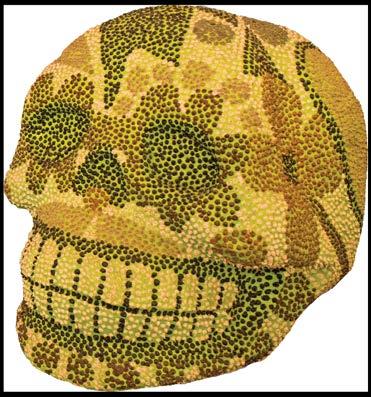The Bull
#INSTAFAME @_CAREYBOY
PG 4
BARBER TO THE BALLERS: TK OFFICIAL

PG 30
MUSEUM OF MEMORIES: VALLEY RELICS
PG26
FLIP THROUGH THE PAGES OF THE LAST BOOKSTORE
PG 24

#INSTAFAME @_CAREYBOY
PG 4
BARBER TO THE BALLERS: TK OFFICIAL

PG 30
MUSEUM OF MEMORIES: VALLEY RELICS
PG26
FLIP THROUGH THE PAGES OF THE LAST BOOKSTORE
PG 24
People from different parts of the world come every day to La La Land—aka the City of Angels, or the Entertainment Capital of the World.
Los Angeles is a treasure trove of cultural, philosophical and geographic diversity, yet it seems at times as though the only thing that connects us is the maze of freeways.
I wanted to discover the people and places that are unique to LA, and jam pack as many stories about them between these pages (and cover our website thebullmag.com with even more).
Social media actors, street vendors and barbers to the stars share space in this issue with a retro video arcade, a museum of Angelino pop culture and a raw vegan restaurant—a rich and varied taste of what LA has to offer.
This semester was the greatest learning experience of my educational and professional career. I was forced to step out of my comfort zone and learned lessons throughout the process.
Also, I want to give a special thanks to advisers Jeff Favre and Jill Connelly, who not only believed in my abilities, but they helped nurture my creative side as well.
So, flip the page. LA is waiting for you.

 Tanya Castañeda
Tanya Castañeda
pg 3
Meet the Cast
pg 4
#Instafame
pg 6
These Walls Tell
Stories
pg 9
Walk this Way
pg 10
The Call of Music
pg 12
Broad Strokes
pg 13
Silent No More
pg 16
Welcome to the Game Grid
pg 19
REVIEW:
Pedaler’s Fork
pg 20
Life Behind Elote
pg 22
The Music Plays On
pg 24
A Page in Time
pg 26

That History
Belongs at Valley Relics
pg 29
REVIEW:
118 Degrees
pg 30
Clipping the Clippers
pg 32
A Curious Cafeteria











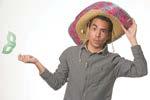

It seems that Alma Lopez is a bit camera shy but she wrote something on page 22.
 Tanya Castañeda Editor-in-Chief
Monica Vigil Social Media Editor
Salvador Fariaz Managing Editor
Jose Herrera Writer
Kayla Berenson Copy Editor
Taylor Arthur Photographer
Kat Wilson Writer
Brian Caldera Photo Editor
Joshua Manes Copy/Design Editor
Lynn Levitt Photographer
Madeline Martinez Writer
Tanya Castañeda Editor-in-Chief
Monica Vigil Social Media Editor
Salvador Fariaz Managing Editor
Jose Herrera Writer
Kayla Berenson Copy Editor
Taylor Arthur Photographer
Kat Wilson Writer
Brian Caldera Photo Editor
Joshua Manes Copy/Design Editor
Lynn Levitt Photographer
Madeline Martinez Writer
Huddled in an intimate circle, surrounding a palm-sized digital camera sitting atop a black tripod, five casually dressed twenty-something year olds break into fits of laughter. Their eyes laser in on the camera’s screen as they review the footage they just shot.

The actors filmed a parody of popular dating websites, such as Match.com, taking turns speaking to the camera about their blunt and gritty expectations of a romantic partner.
Standing a few inches above the rest, Javon Carey asks the cameraman to rewind the footage so he can take a closer look at one of the clips, wrinkling his forehead and lowering his face so that it is now level with the camera.
Carey, known online as Careyboy, writes, directs and acts in comedy skits that he broadcasts to nearly 900,000 followers across several social media platforms. When the 25-year-old decided to move to Los Angeles from Houston in 2016, his popularity on social media preceded him.

“People come up to me all the time and want to take pictures. I didn’t think that I was as known as people make me seem, but when I go downtown
or to Hollywood, people just stop me,” Carey says. Two years ago, he began posting videos to Instagram, his most popular social media account, with more than half a million followers. His ultimate aspiration is to act in film and television, which prompted his move to Los Angeles. The original purpose of the Instagram videos was to give him a platform on which he could practice acting, unaware that it would become his claim to fame, with videos totaling more than 200 million views.
He attributes the quick rise of his page’s popularity to celebrities redistributing his videos. Carey says rapper Waka Flocka was one of the first celebrities to repost his videos. Singer- songwriter Keyshia Cole was also among the first to repost.
Olympic athlete Usain Bolt follows him, comments and frequently “likes” videos on Carey’s page. Carey direct-messaged Bolt, letting him know that he was filming a skit about him, to which Bolt replied, “I will be looking out for it boss and I enjoy the work u do bro keep it up.”
Noticing that his follower count was abruptly rising, Carey began to look at the business side of social media fame. He discovered he could make

a living off his online presence alone.
“This is my job,” Carey says. “The promotions, the advertisements, they come all the time. I had to get a manager to set prices and see what I’m worth outside in this world because everybody’s going to want stuff promoted.”
Carey says he charges anywhere from $1,000-$15,000 per sponsored post on his Instagram page, depending on the popularity of the company.
“Whether they’re with it or not, that’s just what I’m worth because the views and the activity that I get on my page are tremendous,” Carey says. “It would only make sense to charge high up and to look at myself like I’m worth that.”
Karina Walters is a casting director at Fiorentino Casting, and she has been involved in that aspect of the entertainment industry for 12 years. According to Walters, social media is a newly considered side of the casting business, especially if a project doesn’t have a big marketing budget.
“People will think that if someone has a big following on social media, that’s a way to get almost a built-in audience,” Walter says. “If that person has 3 million followers and they’re in something, there’s a good chance that some of their followers will see anything they’re in. They can tweet it out and they can do an Instagram story about what they’re doing and that will get more interest.”
Walters says there’s been a bigger push in the film and television industry to consider social media influencers for acting projects. Although an actor’s online popularity is desirable in this social media era, a high follower count won’t guarantee them a role.
“A lot of those people are talented and a lot of them are lucky,” Walters says. “It’s not to say that everyone on social media is not a good actor, but just like the regular population, some of them are going to be good and some of them aren’t. Just because you have a huge following doesn’t mean you have acting skills. So it’s about finding that balance.”
Carey hopes his follower count will help him in the audition room as he branches out to start an acting career.
His videos aim to find humor in everyday things that will resonate with young social media users. He says he can come up with 20 video concepts in a day. Seemingly trivial moments, such as couples arguing in public, or a disagreement in the workplace, will spark inspiration.
“Ideas come and go. You just have to look at other people’s stuff and see what they didn’t come up with,” Carey says. “I think I’ve done this for a while, so now it’s easy. It just depends on who I’m working with. If you’re easy to work with, then we’ll get through this process real easy.”
Carey usually films twice a week. During these sessions, he tries to acquire enough footage for four or five videos so that he can try to post to his social media accounts three times a week. Once the footage is in, Carey edits the videos. He used to edit on his computer, but he switched over to his cell phone because he says it’s easier and does not restrain him to needing to be at a specific place to get the task done.
His videos usually feature the same circle of actors, who are also building up their popularity on social media through skits
and short videos. Carey’s roommates have Instagram pages and are similarly trying to find success in the entertainment industry.
“I mostly do videos with them. I knew them before I moved to L.A. I knew a lot of people before I moved out here,” Carey says. “We all noticed each other from how many videos we post and from other celebrities re-posting our videos. Depending on if they wanted to collab or not, I contacted them and said let’s work. I’ll work with people who may not even have an Instagram. It’s about whether we can help each other out or not.”
Aspiring actor Milan Carter appears in a handful of Carey’s videos and has an Instagram page comprised of self-written and directed skits. Like Carey, Carter uses Instagram as a stepping stone to outside acting opportunities.


“I feel like social media gives us power as creators, and that’s the best thing,” Carter says. “It’s a gift and a curse. With social media, everything is oversaturated. It gives you the opportunity to express yourself no matter who you are, but it also creates a big ocean for you to try to stand out.”
Carter, who has 26,000 followers on Instagram, thinks the instability of internet trends and the constant change of what is considered funny and worth sharing makes social media success even more temporary and fleeting than the everyday celebrity.
“I feel like social media doesn’t last. If you’re not always on it, your content disappears and you fade to the dust,” Carter says. “It’s no money coming in that way if people just forget. There’s no residuals, there’s no after-the-facts, it’s just here and now. If you have the right mindset and look at social media more as practice for a bigger battle, then I think you’re on the right path.”

“I had to get a manager to set prices and see what I’m worth outside in this world.”
-Javon CareyA camera frames Ty Headlee and Javon Carey as they set up for an Intagram skit in North Hollywood. Javon Carey pretends to kick Ty Headlee while Jalen Turner films for an Instagram skit in North Hollywood.
Hidden inside studio walls in The Brewery Artist Lofts in Los Angeles, vibrant colors dance on the walls as Andre Miripolsky proudly displays his LA-centric work in almost every inch of his creation space. It is in this city that he has truly discovered his creative muse that has allowed him to be self-employed since 1982.
“Looking at my life, my career, my destiny, it’s really been extremely consistent. I mean I am doing exactly what I have done my whole life. I’ve never had a 9 to 5 job. It’s amazing to me,” Miripolsky says.
Son to Los Angeles natives, Miripolsky was born in Paris, France, and he traveled the world as a child.
Miripolsky’s father joined the American
Foreign Service in the early 1950s to provide for his family. This job is what allowed Miripolsky to see the world and exposed him to many different cultures.
As a child, Miripolsky followed in his father’s footsteps and picked up a paintbrush.
“My father was an artist as well and so he always had the canvas, the paints, the easels, all the facilities for me to work with and I picked it up. Instead of a football father, I had a painting father,” Miripolsky says.
By the age of 10, Miripolsky sold his first painting to the American ambassador of Indonesia. It was then that his parents realized he was gifted and fed his artistic side, taking him to museums around the world. This helped him gain a different kind of education outside of the norm.
At 18, Miripolsky decided to move to the United States for college as he decided to settle on one place to call home–Los Angeles. Slowly, he began to focus his artwork on the city.
“It wasn’t a conscious desire to represent LA visually like this. It would just become a thing of my life. It does seem to be a very heavy psychological thing for me, this feeling of belonging, like I’m from somewhere,” Miripolsky says.
Over the years, he found himself getting more involved around the community, and he serves on boards, such as the LA Art Alliance, the Downtown Artwalk and the Hollywood Arts Council. With murals and the phrase “Viva LA,” which Miripolsky created, he has become a pioneer in the branding of the city.

Art history student Joselyn Yang is not surprised that Miripolsky feels so strongly about LA, considering its growing art district and the freedom the city entails.
“There is no judgement out here. You can just really do what you feel,” Yang says.
Although his work has been featured on buildings and billboards, it’s not done yet. Miripolsky is currently focusing on being the creative director on his biggest project to date: the LA Historama. The project is a mural that will measure anywhere from
2,000-6,000 square feet and will potentially be displayed in the newly renovated Los Angeles Convention Center.
The city plans to revamp the Convention Center with new hotels, skyline views and an open campus with gardens. One of the many attractions that may be included is Miripolsky’s work.
The art piece will be made out of stained glass, complemented by LED lighting underneath to make it pop among the city lights.


The inspiration for the piece is Los Angeles.
“It’s divided into three sections: the past, the present and the future. The one element that will be the same throughout is the LA River. That’s my unifying element,” Miripolsky says.
For several reasons it is thought that the river is the best option for the mural’s theme. He believes that the river is a vital part of Los Angeles that has, and always will, be a part of the city. In addition, he believes it is
“My father was an artist as well and so he always had the canvas, the paints, the easels, all the facilities for me to work with, and I picked it up. Instead of a football father, I had a painting father,”
- Andre MiripolskyAlex and Scarlette Stephens kneel to look at one of Miripolsky’s pieces in downtown LA.
a timely theme because there is also a $2.5 billion revamping project on the river as well, according to Miripolsky.
The root of the river is also the most shocking piece of information he has discovered.
“Underneath the San Fernando Valley, there is a gargantuan subterranean lake. That’s where the LA River comes from,” Miripolsky says.
The source of water comes from under the ground in the city of Reseda. The city of Los Angeles was later forced to add concrete as the San Fernando Valley would flood approximately every ten years, according to Miripolsky.
“They had to redirect it because the LA River doesn’t come from a mountain. It just comes out of the ground,” Miripolsky says. “I thought that was one of the most interesting things in my research because I thought this was all a desert, but it wasn’t a desert. The San Fernando Valley was unbelievable in agriculture.”
Miripolsky’s goal for the Historama is to paint a picture through architecture and iconic LA imagery. To complete his vision, Miripolsky has put together a production team and has chosen Judson Studios from Highland Park as the fabricator to do the stained glass work.
Judson Studios was founded in 1897 and
is still family owned today, and currently has a fifth-generation Angelino owner.
Miripolsky believes the history is a great coincidence and complements his story for this project.
“I really do feel like I am the right person to do this,” Miripolsky says. “Even though I’m not a native here, I grew up all over the world and LA is a polyglot. All these people come here from all over the world, so in a way, I am a part of that. But the project is balanced by having the Judson Studio, so it does have the native credibility with it.”
With an upgraded 7,000 square-foot studio in Northeast LA, creative director Tim Carey

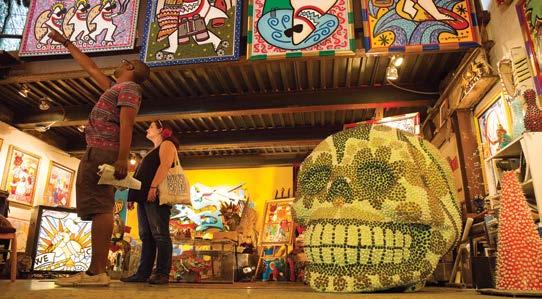
says, “It makes a lot of sense to do it here.”
Although he spent his first 18 years overseas, Miripolsky is a proud Angeleno.
“I feel like I’ve gotten deeper and deeper melting into the city,” Miripolsky says. “At this stage in my life, I’m feeling like LA is my town. It’s my beat.”
The Los Angeles Convention Center expansion is expected to be completed by December 2020, according to lacclink.com.


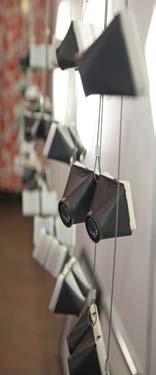
Stowed away in an unsuspecting building in downtown Los Angeles, art studios and artists’ lofts fuse into one art district on Main Street. Twice a year, works of art are displayed in the annual Brewery Art Walk event, where the creators have the opportunity to invite visitors into their personal space to allow others to admire their efforts. This spring, the artists opened their doors for all to see. Photographers, painters and sculptors came together to create masterpieces in LA. In one studio, photojournalist Jim Payne displays his photographs to visitors in a unique way. With several viewmasters hanging from the ceiling, guests were encouraged to pick up his work and
view the 3D images inside of the device. For Payne, his art is a way of life. Working on the same project for years, he sees his efforts as a piece of Americana. He also believes that this lifelong project has helped shape who he is today.
“As soon as you start realizing that your viewpoint is a very limited perspective based upon your experience, then the whole world opens up and you realize how much you don’t know,” Payne says.
 Mike Valdez looks at a 3-D image through the Viewmasters hanging at an artist’s loft during the Brewery Art Walk.
Copy by: Tanya Castañeda
Photos by: Taylor Arthur
Mike Valdez looks at a 3-D image through the Viewmasters hanging at an artist’s loft during the Brewery Art Walk.
Copy by: Tanya Castañeda
Photos by: Taylor Arthur

On a sweltering night inside a dim cantina, glasses clink and patrons burst into drunken laughter, while on the center stage blinding fluorescent lights illuminate the faces of mariachi players. The musicians are clad in suits that match the lit sky, sweating from the hour-long performance of singing, strumming and seducing the audience with love songs.
The final notes escape into the air, which seconds later develop into applause and shouts calling for an encore. Among the players, caressing the sounds out of his guitar, is Roberto Diaz, the director and founder of the group Mariachi Quinto Sol.
“To perform, it means freedom,” Diaz says. “Especially when you’re on stage singing. It’s relaxation, almost like you’re meditating.”
Diaz created his group three and a half years ago after playing for others and
wanting to develop into a more modern mariachi style.
Diaz wants his band to perform mariachi style while maintaining the traditional aspect of it, but also to incorporate new sounds that have a more modern and dynamic feel.
“I find the traditional sound nice and I love it and it’s never going to go away,” Diaz says. “But to me and a lot of younger mariachis out there, which is more proliferated around California, there’s a need to express a different sound that is sometimes limited by tradition.”
Classic mariachi is composed of harmonies (string instruments), such as the violin, vihuela, guitar and guitarron, as well as trumpets.
“A violin is a violin, a trumpet is a trumpet, but when it comes to the harmony part, which is the vihuela, and the guitarron are very specific,” Diaz says. “That’s their own thing right there.”
Within the time frame of the creation
Above: The Ixtapa Cantina has art lining the walls like this piece. It is open late and hosts perform for patrons.
 Story and Photos by: Jose Herrera
Top: Roberto Diaz, 30, performs on stage at Ixtapa, a cantina in Pasedena.
Story and Photos by: Jose Herrera
Top: Roberto Diaz, 30, performs on stage at Ixtapa, a cantina in Pasedena.
of his group, up until the present day, Diaz describes the challenges he deals with to keep the group afloat.
According to Diaz, like any musical group would probably tell you, the beginning is hard because it is easier to join a group and play with whoever they’d like, especially if they have some talent. However, to start a group is tough because work is not plentiful.
“You sometimes have to charge an amount you shouldn’t charge, but you have to do it because you need to get your name out there,” Diaz says. “There’s a lot of experiences. Even your own musicians - when there’s not a lot of work, they don’t want to follow you along.”
As time went on and Mariachi Quinto Sol gained more work experience, networking with different people and companies, Diaz says their name has slowly become more recognized.
“It doesn’t get easier, because there’s always challenges, but you cement yourself, and then you’re able to go with the flow,” Diaz says.
According to Pierce College adjunct music instructor James Bergman, who has lived in three major cities including San Francisco, New York and Los Angeles, all cities offer greater opportunities for musicians.
“All cities are a melting pot, just every pot is different,” Bergman says. “Out here we have a lot of Mexican influence and there are Latin influences in New York, but it’s more Caribbean based.”
Bergman says that of all the cities, LA
is the place to be for both songwriters and listeners.
According to the breakdown of the purchases, the cost of being a mariachi group is approximately $7,000, with each instrument at least $2,000. The sound system is between $2,000 and $3,000, the strings for the violins, guitars and other instruments have to be swapped every couple weeks. Plus the gas driving gig to gig varies, but is an expense that adds up.
helps him to pursue his dream of playing music with legendary players, such as Mariachi los Camperos.

At one point he got to meet Chuy Guzman, one of the Mariachi los Camperos members, during a rehearsal.
“I was very honored [to meet Chuy],” Yañez says. “When I practice, I listen to them and think to myself that I would like to meet them and ask them questions about how they started playing music.”
He says that he loves mariachi and tells everyone about what he does.
“Most people that know me, such as my family members and friends support me and say that it’s cool,” Yañez says. “But for me it’s twice as amazing. I consider myself lucky that I get to play. I’m just a proud musician.”
From performing in front of small audiences, to playing for thousands of listeners, mariachi is an art form that is beloved by many and connects different generations. However, mariachi faces the issue of being misrepresented.
According to Diaz, there is always a misrepresentation about mariachi, which is imagined to be an old fat man with three or four instruments screaming. Diaz has worked on shows, such as Pure Genius, Silicon Valley, and Scream Queens.
“I did a season in Disneyland and the director was like make Mexican-sounds,” Diaz says. “They’re not being racist or stereotyping, it’s just the image that has formed here for a long time.”
The reality is that older men are the minority in this for the most part.
According to Diaz, sometimes you lose money when you’re in charge of a group, because you pay certain people to perform on a certain day or night.
Then there’s the mariachi suit, which is another $1,000. The suit is an investment that they have to renew each year but worth the cost, says Diaz.
“The feeling when you put on a mariachi suit is a very personal experience,” says Diaz. “When you put on a suit you get attention. Most people just respect it because it represents their family and a way of life.”
Isaac Lisando Yañez, 19, is a student at Los Angeles Mission College and a guitarron player for Mariachi Quinto Sol.
He joined the group when he was a sophomore in high school and says it
It’s a lot of young people, from teenagers to men in their 40s. It’s an art form, but what you see out there in movies is not what real mariachi bands are about.
He says that at first he liked being a musician for the perks, but over time his perspective has changed.
“The older you get, the more you understand what it means, where it’s coming from and how it makes you feel,” Diaz says. “It’s not just the superficial aspects of the music, but eventually you start to appreciate what the music means for people who’ve done this for a long time, even before I was born.”
“To perform, it means freedom.”
-Roberto Diaz
Located in downtown LA, The Broad is a contemporary art museum that displays more than 2,000 art works by more than 200 artists.
Designed by Diller Scofidio and Renfro, founders Eli and Edye Broad wanted to create a museum where they could display the postwar and contemporary art that they collected over the course of four decades.
Since its grand opening in September of 2015, the 120,000 square-foot building welcomed 820,000 visitors in it’s first year alone. With two floors of gallery space, it holds artists’ work, such as, Jeff Koons, Chuck Close, Andy Warhol, Robert Therrien, Glenn Ligon and Bruce Nauman.

The Broad Foundation donates to art and philanthropy schools and programs. In 2008, the foundation gave $10 million to create an endowment for programming and arts education, according to the museum’s website.

Founding director Joanne Heyler worked with Scofidio and Renfro to develop an institution dedicated to opening its museum to artworks around the world. The outside structure of the museum is not what you would see on just any building. It’s a piece of art. The “veil” is the dynamic design of patterns and angels that surrounds the building and create a nuanced environment.
The Broad’s modern and historical pieces of art bring a new urban museum experience to downtown LA. Admission is free, and RSVP is suggested a month in advance.

221 S Grand Ave, Los Angeles, CA 90012
Open Tuesdays and Wednesdays, 11a.m. to 5p.m.; Thursday through Saturday, 11a.m. to 8p.m.; and Sunday, 10a.m. to 6p.m. Closed Mondays.
 Double America 2: an art piece consisting of flickering neon lights and electrical wires connected to a number of power transformers, by Bronx artist Glenn Ligon.
Balloon Dog (Blue): a stainless steel statue with transparent color coating. An installment in Jeff Koons’s Celebration, a collection of work that depicts paraphernalia from birthdays, holidays and other celebrations.
A visitor takes a photo of Cy Twombly’s The Rose (V): an abstract expressionist painting of red acrylic roses painted on wood paneling.
Story and Photos by: Samantha Bravo
Double America 2: an art piece consisting of flickering neon lights and electrical wires connected to a number of power transformers, by Bronx artist Glenn Ligon.
Balloon Dog (Blue): a stainless steel statue with transparent color coating. An installment in Jeff Koons’s Celebration, a collection of work that depicts paraphernalia from birthdays, holidays and other celebrations.
A visitor takes a photo of Cy Twombly’s The Rose (V): an abstract expressionist painting of red acrylic roses painted on wood paneling.
Story and Photos by: Samantha Bravo
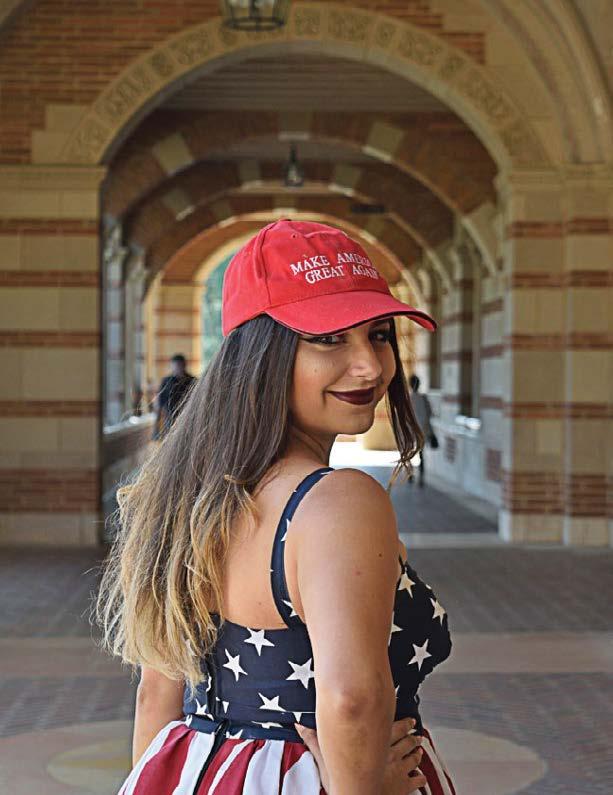 Story by: Kayla Berenson
Photos by: Myion Jackson and Brian Caldera
Conservative club strives to give Republican students a voice in a liberal city
Haley Nieves stands on the campus of UCLA wearing her “Make America Great Again” hat and American flag dress.
Story by: Kayla Berenson
Photos by: Myion Jackson and Brian Caldera
Conservative club strives to give Republican students a voice in a liberal city
Haley Nieves stands on the campus of UCLA wearing her “Make America Great Again” hat and American flag dress.
Swarms of college students blend together, holding their textbooks, coffee cups and laptops, consumed in thought as they hurry to and from class on the University of California, Los Angeles campus. A bright red hat upon a confident young woman’s head makes a statement, standing out among the crowd.
The white capital letters embroidered on the hat read “Make America Great Again.”
Proudly wearing the hat one month into Donald Trump’s presidency is Haley Nieves, a passionate third-year political science and international development studies student at UCLA. She is a member of Bruin Republicans, a club that’s part of California College Republicans for right-of-center college students to discuss the political frontier of the United States.
Nieves joined the club during her freshman year after realizing that she wanted to advocate for conservatives with like-minded individuals. Within weeks of attending several meetings, she was elected as the club’s outreach director and later the external vice president.
“I saw a need for conservatives to be actively organized on campus,” Nieves says. “I wanted to help stand out against the leftist orthodoxy on campus, because it is very prevalent.”
She now serves as the Los Angeles Region Vice Chair of California College Republicans and works as an intern for the Republican Party of Los Angeles.
Nieves says that she and other members of Bruin Republicans are vocal about their conservative views, but some conservative students at UCLA feel the need to conceal their beliefs on a liberalleaning campus in a Democratic city.
College-aged Republicans are a minority in California. According to the Public Policy Institute of California, only 9 percent of Republicans in the state are likely to be between the ages of 18 and 34, while 55 percent are more likely to be older than 55 years old.
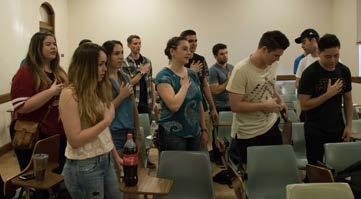
“There can be instances of discrimination,” Nieves says. “There is a social stigma of being an individual who is even slightly right-of-center, independent, conservative or libertarian on campus.”
Nieves believes that one of the reasons these students are uncomfortable sharing their views is that many of their peers and professors base their opinions of Republican college students off stereotypes.
“I think a lot of the stereotypes of Republicans on college campuses in general is that we’ve only come to these positions or that we only caucus with the Republican party, because our parents raised us to be that way or because we come from a red area,” she says.
Nieves was raised by centrist parents, and she says that as a teen, she identified as a social justice warrior. At 16, she became a non-denominational Christian and began to develop socially conservative views. When she was in high school, two of her teachers shaped some of her fiscally conservative beliefs, but she has also formed opinions through research.
have not been as peaceful as the ones with her parents. Nieves believes that UCLA is a tolerant campus compared to other universities in California, but she says there have been times that she has been harassed by students on campus and around the city.
Nieves says that while she was taking down a memorial that Bruin Republicans put together during her second year, a student called her a racist and hit her over the head.
She also says that on Nov. 9, 2016, the day after Trump won the presidential election, she came to class wearing Trump campaign gear to celebrate his victory and she was confronted by another student at a bus stop on her way back to her apartment.
“He proceeded to get on the bus, take pictures of me, follow me back to my apartment, shout at me the whole way there and call me whatever names he would like to think of,” Nieves says.
“I’m very solidified in my opinions and constitutionalized conservative positions,” Nieves says. “I can defend all of my views outside of my religious convictions. Simultaneously, I can be pro-life because I’m a Christian and pro-life for bioethical reasons and for reasons I can derive from philosophy and understandings of natural law.”
Though Nieves and her parents have different political views, she says that her family regularly engages in respectful political discussions.
Her experiences with fellow students
Nieves says that the student recognized her from a viral photo of her holding a sign at a Black Lives Matter protest at the University of California, Irvine. Her sign had the phrase “black lives don’t matter to Black Lives Matter” written on it, but the photo was cropped to just show the first part of the phrase, “black lives don’t matter,” incorrectly portraying her message. However, she says the student on the bus refused to hear her side of the story before making a judgment.
The hostility that Nieves has encountered has come from students who are not members of the political organizations. She says that Bruin Republicans have a healthy relationship with Bruin Democrats, another political club on campus.
“Our clubs are very conductive for engaging political discussion,” Nieves says. “But there
“There is a social stigma of being an individual who is even slightly right-of-center, independent, conservative or libertarian on campus.”
-Haley NievesBruin Republicans recite the Pledge of Allegiance prior to a meeting.
can be some animosity from other Republican and Democratic students on campus.”
Internal Vice President of Bruin Republicans Julia Nista says that some of her more liberal friends have chosen to distance themselves from her because of her conservative views.
“I had a good friend since my freshman year, and over the summer she told me she couldn’t be friends with me anymore because of my political beliefs,” Nista says. “It was really unfortunate.”
Nista says she has also felt silenced as a Republican in some of her classes.
“The teachers assistants are where it’s hard because you can’t openly discuss your political opinions,” Nista says. “They could call you out and potentially grade you down. When it comes to discussions, it’s sometimes better to refrain from talking.”
Nista also says that when she discusses her political views in class, most of her peers are surprised that she holds those beliefs.
Pierce College political science professor Denise Robb has noticed the impact
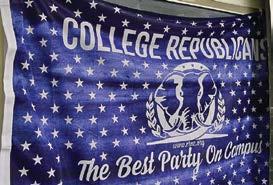
that the 2016 election had on college students in and out of the classroom.
“The election was very traumatic for many of my students, just because of the extreme nature of the candidate,” Robb says. “Many of them were sobbing the day after the election.”
Robb says that she can see a difference in the attitudes of her students as a result of the election.
“The positive thing about Trump’s election is that now students seem to really care about politics for the first time,” Robb says. “It’s really starting to hit home for a lot of them.”

Nieves, who plans on moving to Washington, D.C. after she graduates this year, believed Trump performed “exceptionally well” in his first month in office.
“I think Trump is one of the only presidents who actually intends on following through with all of the promises he made throughout his campaign,” Nieves says.
Nieves hopes to see the California College Republicans and other Republican organizations grow in size,

quality and prominence on campuses.
“Because we are a minority, it is easy to feel like you are alone as a conservative on a college campus,” Nieves says. “We are around other people who are just as energized that it empowers you to go on and do the same.”
In May, 100 days after Trump has been in office, Nieves says that she no longer feels the same confidence in his administration as she previously did. She says that a lot of her frustration started with Trump’s interference in Syria.
“In general, I have been very disappointed with the performance of the administration,” Nieves says. “I believe that Trump has completely turned to the establishment and away from all of the voters that he made promises to.”
Nieves says she doesn’t think that Trump will go back to maintaining his original promises, but she hopes that she’s wrong.
“Honestly, I’m not very hopeful at this point,” she says. “But I would like to be pleasantly surprised.”
Left: Alexis Moran, President of Bruin Republicans, holds a shirt up at a meeting. Top: A banner with “The Best Party On Campus” is displayed on a wall at the Bruin Republican’s meeting.
Inside, it is like walking into a veritable trove of arcade machines ranging from the past 40 years.
The kids’ audible joy melds with the bleeps and bloops of arcade machines that are old enough to belong to their parents. Air hockey pucks smack around the tables, punctuating the laughter and talking that fills the room. The 2,500 square-foot facility is packed, almost every machine occupied by an eager kid or parent trying to get to the next level. On the outside, it looks like another unit of the warehouse plaza off Plummer Street in Chatsworth.

Any person with a casual appreciation for arcade games will stand back in awe of seeing classics, such as Mario, Crystal Castles, Gauntlet and Q’Bert, along with arcade favorites from recent decades, including Silent Scope, Time Crisis, Dance Dance Revolution and the Terminator arcade game.
This arcade was designed with almost surgical precision to target the gamut of gamers, regardless of age and playing style. Walking around the facility, it’s immediately apparent that both children, mostly younger than 10, and their parents
Story by: Kieran MacIntyre“You want to know why arcades are now so important in Los Angeles? It’s ‘90s nostalgia and the joystick fire button combo,”
-Phil Moore
can share the experience, something that is lost in the console gaming that is currently in vogue.
Royce D’Orazio, the owner of the eponymous arcade, sits behind the counter surrounded by a swath of pop culture memorabilia. He collects money from customers taking advantage of his arcade’s $3 unlimited play time on a cloudy, damp Saturday afternoon.
What started as a simple repair and rental service for arcade machines in D’Orazio’s garage has transformed into a multifarious business that is injecting nostalgia into the 21st century Angeleno social life.
“I started with nothing but street signs with no words, just dots and arrows, Pac-Man and ghosts, and people would come to me like, ‘I saw the arrow, I followed the dots. I didn’t know where it was going to take me, but I knew it was going to take me somewhere cool,’” D’Orazio says.
He explains that after parenting blogs and news media picked up his stuff, constantly setting up the sign trail became unnecessary.
D’Orazio, a Philadelphia native in his 30s, shifted from working in the entertainment industry once his talents for arcade repairs proved to be profitable. Talking to him is like listening to an amalgamation of a fervent gaming fan and an astute businessman whose ambition for future projects is palpable. He knows the lexicon of gaming and he translates it into a business model.
He offers arcade machine rentals, restorations and repairs across the Southland, as well as hosting affordable parties in the warehouse space and $3 dollar unlimited play for all two times a week during the school year.


Royce is experiencing a meteoric rise as one of Los Angeles’ few arcade guys riding the nostalgia wave that has swept the city.
A casual consumer of contemporary pop culture can immediately recognize the fervor for arcades and all things ‘90s.

Many icons who were successful in this era are seeing a resurgence because of this.
“You want to know why arcades are now so important in Los Angeles? It’s ‘90s nostalgia and the joystick fire button combo,” TV host and producer Phil Moore jokes about the revival of the arcade experience. “The ‘90s are a huge influence on entertainment today. Take ‘Fuller House,’ the Disney live action remakes, the Power Rangers movie, etc.”
 Eliza Ramallosa focuses on her video game.
Steve Dorgstrom (left) watches grandson Chase Dorgstrom (right) play Silent Scope.
Eliza Ramallosa focuses on her video game.
Steve Dorgstrom (left) watches grandson Chase Dorgstrom (right) play Silent Scope.
“As the former host of ‘Nick Arcade’ on Nickelodeon,” Moore continues. “I’m making more appearances at [conventions] and gaming expos than ever before, because those ‘90s kids are now adults and they love reliving the childhood. And playing classic video games is an important part of that experience.”
A $3 arcade adventure may sound like a great deal, but it is actually a well plotted move for D’Orazio.
“Creating the arcade experience was a marketing strategy. When I opened, I was doing party rentals. I got this space and thought the best thing I have going for me are the games, so I put them to work. I mean this product is not a hard sell,” D’Orazio says.
Over time, numerous aspects of D’Orazio’s approach to conducting business have changed.
“I used to let people come here for free because I thought people will love it and find ways to embrace the business,” D’Orazio says. “Now, we charge an admission fee, which has become its own revenue stream.”
This thought out marketing tactic has garnered praise from a slew of blogs and the L.A. Mayor’s office as well.
“We got recognized by the Mayor’s office and several other entities. I wasn’t looking for those things but it’s really cool,” D’Orazio says.
Walking around the arcade, it isn’t difficult to find a parent who has something good to say about it.
“My kids really enjoy coming here. We go almost every Saturday now,” says mother of two Linda Henderson. “It’s so cheap and getting my daughter to play Pac-Man beats her begging for my phone to play Fruit Ninja.”
As the arcade continues to grow in popularity, it has proven to be as beneficial for kids with disabilities as well.

“There’s a massive social component that’s lost on the console where you see kids are isolated. Something that I discovered is that for children with autism or Asperger’s syndrome, this place is very good for them,” D’Orazio says. “We get kids like that, and not only does it feed all of their senses, but to find the next game they have to actually be social, so it forces them in a very natural way. I never expected kids be nurtured by the arcade.”
It is an unconventional thought to label an arcade as nurturing, but as D’Orazio says, it makes sense.

“You’ve got to remember when
arcades existed [in the ‘70s and ‘80s], autism was a fringe disability,” D’Orazio says. “They come in here and it’s like their own place. I guess it’s soothing to them. I can’t speak for them, but I just had one of these kid’s mothers come back and when we were talking, she said when her son comes here, he feels empowered.”
While parties remain the centerpiece of the arcade, he plans to produce social media content to build the brand’s presence on the web, including videos on the popular gaming streaming service Twitch.
“We [plan on] rolling out content every day of the week, video content like toy unboxing, vintage game displays, interviews, round table discussions, Twitch competitions,” he says. “You could come here on a Friday and play someone in Street Fighter live on Twitch and also potentially see your gameplay posted on our social.”
On top of the new content, sometime in the near-future D’Orazio hopes to open a new facility that feels more akin to an indoor Disneyland, with a mini kart
track and possibly even a roller coaster, if the desired space allows it.
The goal for D’Orazio is to keep arcade gaming alive for the next generation.
“There’s a way parents connect with their kids here that they’re not going to get at Chuck E. Cheese. You can show your son or daughter how you play Donkey Kong and get them involved. That’s something you can’t get at home.” D’Orazio says. “Arcades are essential in nurturing the younger kids to hopefully keep the arcade experience alive.”
Royce’s Arcade address: 21817 Plummer St, Chatsworth, CA 91311
$3 Dollar Unlimited
Play Hours: Friday 4pm - 7pm, Saturday 10am3pm
Arestaurant, bike shop and coffee shop combine under one roof at Pedaler’s Fork in Old Town Calabasas.
Friendly faces greet incoming visitors and offer outdoor or indoor seating, both of which are adorned with old photos and bike models that are aesthetically pleasing. Views of the quaint city can be seen from any seat in the restaurant.
The spacious venue offers a menu with a wide variety of options for meat lovers, vegetarians, vegans and those allergic to gluten. The extensive selection of entrees ranging from salads to sandwiches, can be overwhelming at first glance.
Executive chef Dan Murray tests food boundaries throughout the menu, putting a spin on many traditional dishes.
A popular starter that is large and filling enough to eat as a meal itself is the avocado toast. Sourdough bread topped with avocado, cucumber and zaatar combine in a satisfying and unique taste.
The curried cauliflower fritters, a starter served with yogurt raita, transforms the once bland vegetable into an appetizer bursting with an unexpected yet enjoyable flavor.

It may be surprising to discover that the baby kale salad is a vegan option. Almond cheese serves as a replacement for the original parmesan and a vegan-friendly dressing is used. The restaurant also gives the option of adding tofu, salmon or chicken to all of the salads.
The dessert section of the menu doesn’t offer as many choices, but still provides guests with a selection of delicious options. The flourless chocolate cake tops off any customer’s meal with a sweet and rich taste that can be enjoyed by kids as well as adults.
A disappointing item on the menu is the vegetable pizza. Sun dried tomatoes, squash, zucchini and cheese topped on the dough add color to a dish that lacks flavor and tastes more like a dry vegetable flatbread than the classic Italian favorite.

With reasonable prices, a simple three-course meal at Pedaler’s Fork is affordable. The cheapest items on the menu, the avocado toast, soup and salted caramel bread pudding are $7, and the most expensive dish, a large family-style platter of meat and chicken, is $68.
The restaurant serves lunch and dinner Monday to Friday from 11 a.m. to 10 p.m.
The peaceful and trendy environment, friendly service and diverse menu at Pedaler’s Fork make it a great place to spend an afternoon or an evening with friends and family.

Alime green cart bumps along Vanowen Street, a pop of color against the gray concrete. The cart’s bell jingles as the wheels maneuver over the cracks in the sidewalk. With its chipped coat of paint, the wood near the bottom shows its true signs of wear.
A man pushes the cart as he honks his horn. The honking serves as his call to every home he passes. Otherwise, he is quiet as he strolls down the street, pushing his green sidekick along the path, his cart bursting with wares.
This man is Juan Poodmx and the cart is his sole income for his family. Poodmx is a 30-year-old street vendor serving Los Angeles County, providing Mexican comfort food to the Canoga Park and Winnetka areas.

The green cart that Poodmx built has been the other half in a one-man business of selling Mexican-style corn and street food that is commonly found in his hometown of Mérida in Yucatán, Mexico. He says he decided to come to America to sell because he needed new customers.
“I came here when I was 20 years
old,” Poodmx says. “I didn’t have any job when I got here, but I needed to help my family.”
Poodmx has equipped his cart with a large metal pot that holds steaming ears of elotes, a Mexican style cornon-the-cob. Poodmx also sells bags of chicharrones, which are pieces of fried pork crackling that he coats with a hefty squirt of chile and a spray of lemon juice. Poodmx is quite comfortable in this business of nomadic vending.
“I’ve been selling corn around here for 10 years,” Poodmx says. “I know what I have to do and how long it takes
me to do it.”
Jars of various sizes clutter the small area, holding the mayo, crumbled cheese and squeezable butter- iconic items used to dress up a traditional elote. Also on the cart is a big block of ice for shaving his own raspados, a Mexican version of shaved ice and syrup.
In addition to serving traditional syrup that Americans use to cover shaved ice, including cherry and blueberry, Poodmx also serves homemade Tamarindo, a popular Mexican drink made of juice from the Tamarind legume boiled with sugar.

Poodmx has been at this for a while, so preparing his cart each day has become second nature to him.
“Everything is quite easy and quick for me to prepare,” Poodmx says. “The only thing that takes time to make is the Tamarindo, which is natural. I make it fresh daily.”
With a desire to support his family, he leaves his home in Mérida for twoto-three-year spurts to come to LA and collect his business earnings. Once he has stayed long enough, he travels back home to be with his family.
“I do all of this to lift my family up, to bring them forward and closer to success so that we can all be happy,” Poodmx says.
Up the street, atop a set of stairs of a duplex, there is a woman who waves to get Poodmx’s attention. They nod to each other, too far apart to hear any words, but close enough to share a mutual understanding. Poodmx stops his cart at the edge of a fence that leads into her building as he waits for her.
Vanessa Mena has been Poodmx’s customer for around three years since she moved to the area.
“I absolutely love the way he makes his elotes,” Mena says. “His products taste fresh, and he just knows how to make the corn taste better than it’s ever tasted before.”
Along with Mena, others in the neighborhood flock to Poodmx as he passes with his cart, ready and eager to buy his corn and snacks.
“I like this community,” Poodmx says. “They are very loving and generous.”
Although it is now legal to be a street vendor, Poodmx hasn’t let his guard down when it comes to roaming the streets.
“It is not uncommon for the police to take my cart from me or cite me,” Poodmx says. “It sucks because all they do is throw it in the trash.”
To accommodate this struggle,
Poodmx keeps a few extra carts in his home so that he doesn’t lose a day of work.
Veronica Bauchman is the bureau director of the LA County Department of Public Health. She specializes in many programs, including the Street Vending Compliance Program.
With the legalization of street vending, Bauchman strives for all roaming vendors to become licensed. Most street vendors’ carts are so small that they don’t have room for carrying sanitation of any kind, Bauchman says.
“It’s really unsafe for both the sellers and the customers when it comes to business on the streets,” Bauchman says. “Those who don’t have permits must rely on their empathy for fellow humans to conduct their business up to health code standards.”
Poodmx makes sure that his products are safe for his customers to consume.
“My entire business is dependent on my loyal customers,” Poodmx says. “If I make someone sick, they won’t buy from me and they will spread the word that I’m not a good vendor.”
Poodmx says that he isn’t seen as a vendor in the eyes of the government, which is one hurdle he chooses not to go over.
“I’ve tried getting a permit in the past,” Poodmx says. “It’s just impossible for us to get one.”
With the worry of not complying with county rules, Poodmx fears citation from the police every day he ventures to work.
“It sounds scary, but it’s not so bad,” Poodmx says. “I am friends with other elote vendors and we work together to stay safe. There’s nothing else I’d rather be doing.”

For the average Angeleno, a typical Thursday morning usually involves prepping for school or work, fighting traffic and grabbing a quick bite and a cup of coffee.
For Dori Accordino, Thursday is when she drives her Lincoln Town Car to St. Charles Borromeo Church in North Hollywood because it’s the place she knows there’s a free meal.
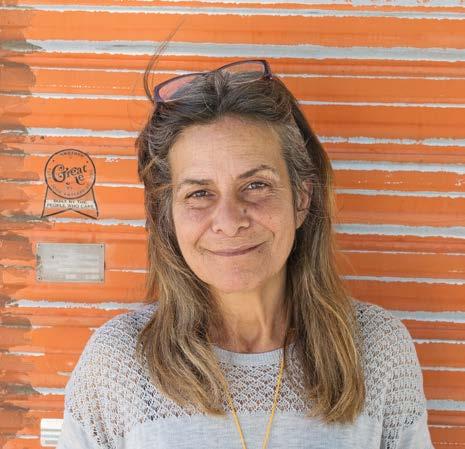
Walking into the Holy Family Center at St. Charles, no one would probably guess she once owned a growing day spa and that she dated pop music legend Prince.
Now living out of an RV, Accordino said her childhood portended a bright future. At 9, she was already studying music and singing. In her teens she began taking acting classes to help round
out her skills to be a performer.
In class, she met the assistant of the vice president of Warner Brothers, who helped her secure a job at the entertainment corporation. One day, while on the job, a girl approached her and led her to Prince.
“She walks me over to him. He was very shy then. I said, ‘Hi, I’m Dori.’ He said, ‘Hi, I’m Prince.’ From there, it’s history,” Accordino recalls.
Prince invited her to his show that same night at The Roxy Theatre in West Hollywood. Accordino accepted the offer and joined the crowd.
The year was 1977. Both Accordino and Prince were 19 years old, and although they did not know it at the time, Accordino says they were soon to fall in love.
“We sat in the car for four hours after
and talked, just talked,” Accordino says. “We got to know each other a little bit and we really liked each other.”
While getting to know one another, Accordino expressed her love for music and mentioned her songwriting to him. Prince offered to listen to her work.
“He flew me out to Minneapolis to visit him. I brought one of my songs,
“[Homelessness] can happen to anyone. It’s one of the toughest things to overcome in life.”
-Rebecca Inez
‘Heart Attack,’” Accordino says. “So he put music to that and kept it.”
Although she says Prince was her first love and soulmate, Accordino believed she could not maintain the relationship due to his constant traveling. She wanted someone local that could be there for her. During one of Prince’s concerts at the Hollywood Forum, she decided to call it quits.
“I went to his show and he saw an engagement ring on my hand. He said, ‘What’s that?’” Accordino remembers. “I said, ‘Well, yeah because you’re always gone and I’m always here.’ He was pissed.”
Throughout the years, Accordino has kept her memorabilia close to her camper, which includes a letter Prince wrote to her. It begins with “Hello Love,” and ends with “Help me, I think I love you.”
Although she says she still had feelings for him, she moved on with her life. Years later, she decided to open a spa specializing in therapeutic massages, facials and nails. As her business began to thrive, she says her business grew until she hired 10 employees. However, her life got derailed when she suffered from an aneurysm that left her in a coma for three weeks.
“I was working in the studio one night at home and I felt kind of weird, so I went down to the bathroom,” Accordino says. “I looked at myself in the mirror and I had black blood under my skin and I fainted. That’s how I ended up at the hospital.”
Although her coma lasted three weeks, Accordino remained in the hospital for


almost a year, receiving treatment for her back and feet. Today, the left side of her body is paralyzed and, while still able to walk, she has a noticeable limp.
The prolonged hospital visit caused her to lose her Studio City home and to file for bankruptcy. She also lost her spa, which she had opened four years before her aneurysm.
Homeless and broke, she wound up living in an RV.
Rebecca Inez, a homeless woman visiting the same church for a Thursday morning meal, says that homelessness can occur to anybody.
“You think, ‘That’s never going to happen to me,’ but then it does.” Inez
says. “It can happen to anyone. It’s one of the toughest things to overcome in life.”
Professor of journalism at CSUN and Pierce College Dave Blumenkrantz is working on a documentary on the homeless population. He believes that Accordino’s story is a common tale.
“Many of the homeless people I’ve met in the course of this documentary project, whether in a facility where they are seeking some sort of assistance, or just in passing in the streets and in the encampments, have shared similar experiences to Dori’s,” Blumenkrantz says.
Blumenkrantz has gone to the center several times, searching for visitors willing to sit in front of the camera and share their story for his project.
It was during one of his trips to the facility that Blumenkrantz first came across Accordino, who stood out to him.
“Dori struck me as a particularly interesting person, not only because of her musical background, but her optimism and cheerfulness,” Blumenkrantz says.
Accordino hopes that positive attitude will benefit her with future endeavors. She plans to continue playing music and record a hit record with the help of a guitarist friend. She also hopes to publish a book one day to get her story out to the world.
For now, Accordino can usually be found traveling the city in her RV and enjoying a free hot meal on Thursday mornings.
Dori Accordino shows photos of her younger self.Home to more than 250,000 books and no database to keep track of them all, The Last Bookstore is a literary treasure hunt where you truly never know what you might find. The store buys, trades and sells used and new books, LPs, DVDs and CDs. They also host readings, concerts, plays, film screenings and more.
Entering, you leave reality behind and lose yourself in the catacomb of shelves and tunnels made from books as well as plush couches and chairs.
Store owner Josh Spencer is passionate about books and chose the name “The Last Bookstore” because of the decline of bookstores as a whole.


“There is press about books going away

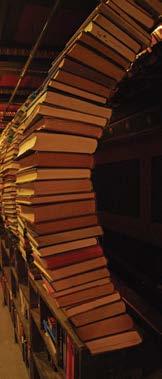
and e-books taking over,” Spencer says. However, he believes the threat of online copies may motivate people to keep the printed versions alive.
“I think the digital age has made print books more popular,” Spencer says. “It’s made everyone come out of the woodwork who really want to see books survive.”
Spencer usually starts his mornings at the bookstore’s warehouse. He can sort through stacks of books without haste and separate weathered books from sellable in seconds. Books in good shape are taken to the store while others are boxed for storage or prepared to give away to the needy.
“It’s kind of a fantasy job for anyone that likes books,” Spencer says. “ It’s not even work for me.”
A stack of books glued together creates an archway for people to walk through at The Last Bookstore in downtown LA. Right: Two men stand outside the entrance of The Last Bookstore in downtown LA. Bottom: Customers approach the counter made of several stacks of books glued together at The Last Bookstore in downtown LA. Copy by: Lynn Levitt Photos by: Taylor Arthur and Lynn Levitt Far right: Two customers pause to read books at The Last Bookstore in downtown LA.We need:
Editors
Writers
Photographers
Videographers
Illustrators
Join one of these classes and have your work published in print:
Journalism 220
Learn the theory of writing, editing and producing a magazine. Writing and editing of copy, designing pages, selecting photographs and other illustrations and design materials, preparing them for production; arranging production schedules; and other aspects of publishing are included.
Journalism 223
Learn the theory of writing for a magazine. Focus is on research, reporting and writing. Writing and editing of copy, working with editors, photographers or illustrators, preparing articles for production; arranging production schedules; and other aspects of publishing are included.
Photography 37
Gain practical experience in taking photojournalistic pictures and video including news, sports and features. Learn video editing, Photoshop and layout skills to showcase your still and video images in online publications.
For more information about these classes, contact Jill Connelly at conneljp@piercecollege.edu or Jeff Favre at favrejj@piercecollege.edu.


When entering the Valley Relics Museum, the love for Los Angeles is immediately apparent. Racks of t-shirts line the walls proudly displaying the defunct logos of family-owned companies from the San Fernando Valley’s past. The glass counter is stocked with small pieces of memorabilia and merchandise, including coffee mugs, tote bags and bumper stickers stating, “History is Beautiful.”
The museum began as the personal collection of the owner, Tommy Gelinas, who began collecting matchbooks, postcards, yearbooks and

history books in an effort to preserve the fading history of his hometown.
“Growing up as a kid in the San Fernando Valley, there were so many wonderful things to experience, and as I got older, I found myself explaining to newcomers what we used to have,” Gelinas says. “And the more I found myself explaining, the more I asked myself, where did it all go?”
Gelinas started sharing his collection online and began to garner an interest from valley locals, who would ask to see his artifacts in person.
“I started posting on early social media such as LiveJournal, Myspace
and eventually Facebook,” Gelinas says. “It started to fuel the curiosity of a lot of people who didn’t know the history of the Valley. It really started to fuel the idea of opening a museum.”
The Chatsworth Museum opened its doors in July of 2013. Beginning with Gelinas’ collection of 5,000 objects. The museum now holds about 15,000 artifacts including memorabilia, books, statues, automobiles, neon signs and other odd pieces of history. The staff at Valley Relics is constantly on the lookout for new additions.
“It’s exciting when we find a piece of history that has been somewhat
lost. Researching it is like going on an adventure every time. It’s a hobby, it’s a passion,” museum staff member and researcher Mary Neubauer says.
After a larger object is found, Gelinas and a member of the museum staff will rescue the artifact, which is usually a sign or statue.
“A lot of it is like a treasure hunt. We are constantly keeping our eyes and ears open, whether it’s on eBay, a yard sale or a thrift store,” Gelinas says. “But due to the progression and popularity of the museum, a lot of the artifacts fall on our lap.”
Valley Relics is often asked to lodge big display pieces that are



in between placement, such as the Television Academy’s towering Emmy statues, or more recently, the housing of the Porter Ranch cowboy statues.
The museum receives many old neon signs, photos and materials from local defunct businesses. The neon signs have been restored to working condition, but have kept the grime and rust they had when they were proudly displayed on their respective establishments.
“When people think of restoring they think of repainting and all that. No, what we want to do is keep the nostalgic feeling of the color and all the paint chipping away, but fix the neon and get

them lit back up,” museum staff member and electrician Shane Stewart says. “But leave it exactly the way it is, because that’s when it has more heart behind it. If you go and paint it, then it’s not original.”
The museum is funded mainly by donations and t-shirt sales, which was made possible by Gelinas’ garment decorating business, the Print Lab, which he founded in 1995.


“I needed to find a way to create some type of revenue stream to help keep the doors of the museum open,” Gelinas says. “So I was researching a lot of these local companies to see if there was any trademarks, or find the

owners. I come to find out, a lot of these companies have been closed for 25 years, 30 years. There was never a trademark.”
Many of the owners are pleased to see their family businesses revived in some way and donate more of their personal remembrances to the museum.
“They’re happy that we’re keeping their family’s legacies alive,” Gelinas said. “Even though there’s no trademark, we have their blessing.”
Gelinas says the museum isn’t just for valley locals. The sheer amount of manufacturing and production the San Fernando Valley has achieved has had an impact on shaping the nation as a whole.

“It’s a mecca of history, but it’s really hard to prove because most of that history is gone,” Gelinas says. “The valley deserves a museum, it deserves a spotlight on its history.”
21630 Marilla St, Chatsworth, CA 91311
Open Saturday from 10a.m. to 3p.m.
Top left: The founder of Valley Relics, Tommy Gelinas, working the store counter at the entrance of the museum. Bottom left: An original Los Angeles silk scarf souvenir, circa 1930’s, donated to the museum. Bottom right: The Indian statue that curates the cowboy room at the museum was originally part of Knott’s Berry Farm’s Ghost Town.
118 Degrees offers vegan food that tastes vegan, and not in a good way. Offering tasty raw, healthy, vegan food is difficult because options are limited. Almost all the dishes at this restaraunt could be improved with some salt or pepper, but then the dish would no longer be “healthy.” The cheese dishes would taste better if they are fully cooked, melting the cheese. However, the entrees would no longer be raw.
Dainty golden chandeliers hang above every other table, and bright, fake grass lines the walls and benches in the Tarzana restaraunt.
Online, its website reads: “our cuisine is entirely plantbased, made from fruits, vegetables, nuts, seeds and sprouted grains-- all prepared at 118° or lower to preserve valuable nutrients.”
The “Yogi Juice,” priced at $5, is a mixture of orange juice, berry juice, maca root and lemon juice presented in a clear Mason jar.

The taste is sour and overpowered by the amount of lemon juice the drink contains. The berry flavors get completely lost in the mix. When the citrus overtones clear, they give way to an unpleasant aftertaste, which resembles burnt hair. The aftertaste is too strong and bitter to ignore, making the entire drink a loss.
The “Living Lasagna” dish is made up of zucchini, macadamia ricotta, sweet basil marinara, mushroom and a cheese crumble.
The marinara cheese and mushrooms taste chilled while the
zucchini is warm, causing the ingredients to mix awkwardly. In addition, the overall taste of the dish is bland. If there are any seasonings on the lasagna, they can not be tasted. The marinara’s only flavorful component is the sweet basil, though the taste was not strong enough to save the dish. For $15, the entree was too expensive.
The “New Mexico Nachos,” $10, use carrot crisps in place of traditional tortilla chips. The carrots are topped with cilantro salsa, chipotle cheese, sweet cheese, guacamole and cilantro. Aesthetically, the plate is pleasant and polished. However, the nacho experience was diminshed because the carrot crisps are weak and brittle, unable to hold more than a few ingredients without breaking. The chipotle cheese alone, with its smoky and spicy flavor, redeems the entree, which would have otherwise been a bust.

For dessert, the “Chocolate Avocado Cacao Brownie” hits the spot. The texture resembles fudge more than a brownie, which is for the better because the dessert is served cold. It is topped with hemp seeds, providing a subtle crunch throughout, adding an enjoyable variation to texture. The dessert is bitter in the way one expects cacao to be.
Vegans aren’t always necessarily looking for their food to taste like meat, but they shouldn’t have to settle for less flavor.

NBA stars are constantly in the spotlight. They need to have the newest kicks, the freshest clothes and blinged-out watches; it may as well be a part of the job description. One of the biggest aspects of the overall swagger a player must uphold is “the cut.”
If you walk on the court with a bad haircut, you’ll be a trending topic on Twitter within an hour. A haircut is a way to express who you are and how you feel. So having a good barber is crucial.
Anthony ‘TK Official’ Bennett is an in-demand barber in the San Fernando Valley that has cut hair for Klay Thompson, Chris Paul, Doc Rivers, Austin Rivers, Deandre Jordan and other NBA players.

“When I got into barbering I told myself I needed to change my nickname into a barber-type name,” TK says.
He went with the name ‘Too Krispy’ which later evolved into TK official when he started working at A Cut Above on Topanga Canyon Blvd. in Woodland Hills, Calif.
TK learned how to cut hair after years of watching his father give himself and TK haircuts. His mom bought him a pair of clippers after his parents split up and he began to cut his own hair.
Story by: Salvador FariazPhotos by: Lynn Levitt
“After four years, I started cutting my homeboy’s hair and when I was 22, I finally decided to be a barber,” TK says.
His first big-name client was R&B singer Mario. Before he was a barber, he ran into Mario at a Subway, while they were getting food. He ran into him a second time at the mall and used it as a business opportunity.
“I was like ‘yo, remember me?’” TK recalls. “‘Remember you told me to heat up my tuna at Subway?’ and then he remembered. So I told him I was a barber and that he should come through, so he took my number down and a couple days later, he hit me up for a cut.”
He cut Mario’s hair and got a big response off social media after posting the picture on his Instagram page.
But the cut that really put him on the map as a barber was when he cut NBA All-Star Klay Thompson’s hair in 2015. One of TK’s friends from high school saw that he cut Mario and NBA forward Wilson Chandler and that friend happened to be hanging out with Thompson and Thompson’s brother.
“So one day he hit me up and said ‘me and my boys need cuts’

and when I went over there, it was Klay Thompson,” TK says. “After I cut Klay’s hair, I started getting a lot of love and that’s when Austin Rivers hit me up, Reggie Bullock, Marshon Brooks, Joe Johnson and a lot of up-and-coming players.”
Daniel Durbin is a clinical professor at the University of Southern California and says that the style and appearance of an NBA player goes beyond just trying to look good; it’s all about business.
“The style of a player has a lot to do with branding,” Durbin says. “Athletes now more than ever understand how lucrative of an opportunity endorsements are now. They want to get their name and style out to the public in order to increase their brand.”
A lot of the success TK has had in his career has come from the use of social media, where he has 13,400 followers on Instagram.
“Honestly, Instagram is where I made all of this happen,” TK says. “You can go to the mall right now and approach a couple people and tell them what you do but you can only do that so much. Instagram has millions of people on it and you can hit up whoever you want.”
TK says you have to put your pride aside when messaging people on Instagram to find clients.
“A lot of men don’t want to hit up another man like,‘bro you should come check me out, I’m a barber in the area’ but I was hungry,” TK says. “I had a copy paste thing I would do that said, “Hey man, what’s going on? My name’s TK the barber and I’m a new barber in LA…’ and a lot of them hit me back.”
He has already begun to achieve one of his biggest goals. He aspired to get on production sets to cut hair.
“One of my goals this year was to get on set because that’s more money and more exposure. I started cutting Chris Paul’s hair in February and I went on set with him once already.”
Another goal for TK is to own his own shop and product line one day.

“I want to keep the revenue coming and take it to the next level. Besides that I just want to keep getting better and keep making my service better,” TK says.
Fidel Becera worked with TK for six months at A Cut Above and says that he was a master at his craft, but always stayed humble.
“He was really humble. There are barbers who are stuck up and wouldn’t talk to you if you asked for tips or pointers, but that wasn’t him,” Becera said. “He is super detailed with his work and he took time to listen to his clients and to make them feel comfortable.”
Cutting hair isn’t the only thing that takes up TK’s time. He also produces music and does some photography on the side.
“I’ve been messing with music my whole life,” TK says. “I got my first keyboard when I was 10, but before that whenever I was at my grandma’s house using hers.”
TK loves to sing and write and he incorporates all of that into his music.
“That was the only compliment I ever got in school, that I was a good writer,” TK
recalls. “As I got older, my friends and I would always freestyle. When I was 14 we bought a microphone from Target and we used a recording software that was already on the computer. We didn’t know what the hell we were doing.”
2015 was the year he fully committed to making music and he bought all the equipment he needed to make his tracks. One of his clients taught him everything he knows about how to use the music software and how to make beats.
He put barbering back as his main priority this year because his music wasn’t making him any money.

Taking photos of his clients after he finished cutting their hair ultimately got him interested in photography.
“What really got me into it was being a barber,” TK says. “Instagram is so big for barbering, so people started getting expensive cameras so I got it for that but then I wanted to shoot models and girls.”
However, photography is no longer a big part of his life now either.
“I was into that for a little while but it was taking too much time to edit the photos and to set up the shoots,” he says. “It was taking time away from what I needed to do.”
TK now focuses on cutting hair and getting his client list up. To follow what he is up to, his Instagram handle is @tkofficial_.
“I want to keep the revenue coming and take it to the next level. Besides that I just want to keep getting better and keep making my service better.”
-TK Official
Sitting near the intersection of Broadway street and 7th street in downtown, Clifton’s Cafeteria invites strolling pedestrians to enjoy its luxury cafeteriastyle dining.


The multi-storied restaurant is dimly lit, the exposed wood furniture contrasting against the pops of green foliage. Stuffed woodland creatures decorate the space while a grandiose tree commands attention and provides an outdoorsy ambiance.
Customers line up, often beginning outside the door and against the building, waiting for their chance to fill up their trays with hearty entrees, such as pork ribs and lamb shanks.

Clifford Clinton opened the restaurant in 1935. After a multi-million dollar renovation, it reopened in 2015.
According to latimes.com, a working neon sign was discovered during the restaurant’s renovations. The light was turned on approximately 80 years prior and had been forgotten about and left on until its rediscovery in 2012. It is estimated that the sign accumulated about $17,000 worth of electricity bills throughout the years.

 Pedestrians walk past Clifton’s Cafeteria on Broadway St. in LA
An illuminated neon sign leads customers to the dining area at Clifton’s Cafeteria in LA
A candy rack sits on display at Clifton’s Cafeteria in LA
Clifton’s sign lights the way at Clifton’s Cafeteria in LA
Patrons sit at a table watching passing traffic outside through a window at Clifton’s Cafeteria in LA
Copy by: Monica Vigil
Photos by: Taylor Arthur
Pedestrians walk past Clifton’s Cafeteria on Broadway St. in LA
An illuminated neon sign leads customers to the dining area at Clifton’s Cafeteria in LA
A candy rack sits on display at Clifton’s Cafeteria in LA
Clifton’s sign lights the way at Clifton’s Cafeteria in LA
Patrons sit at a table watching passing traffic outside through a window at Clifton’s Cafeteria in LA
Copy by: Monica Vigil
Photos by: Taylor Arthur

